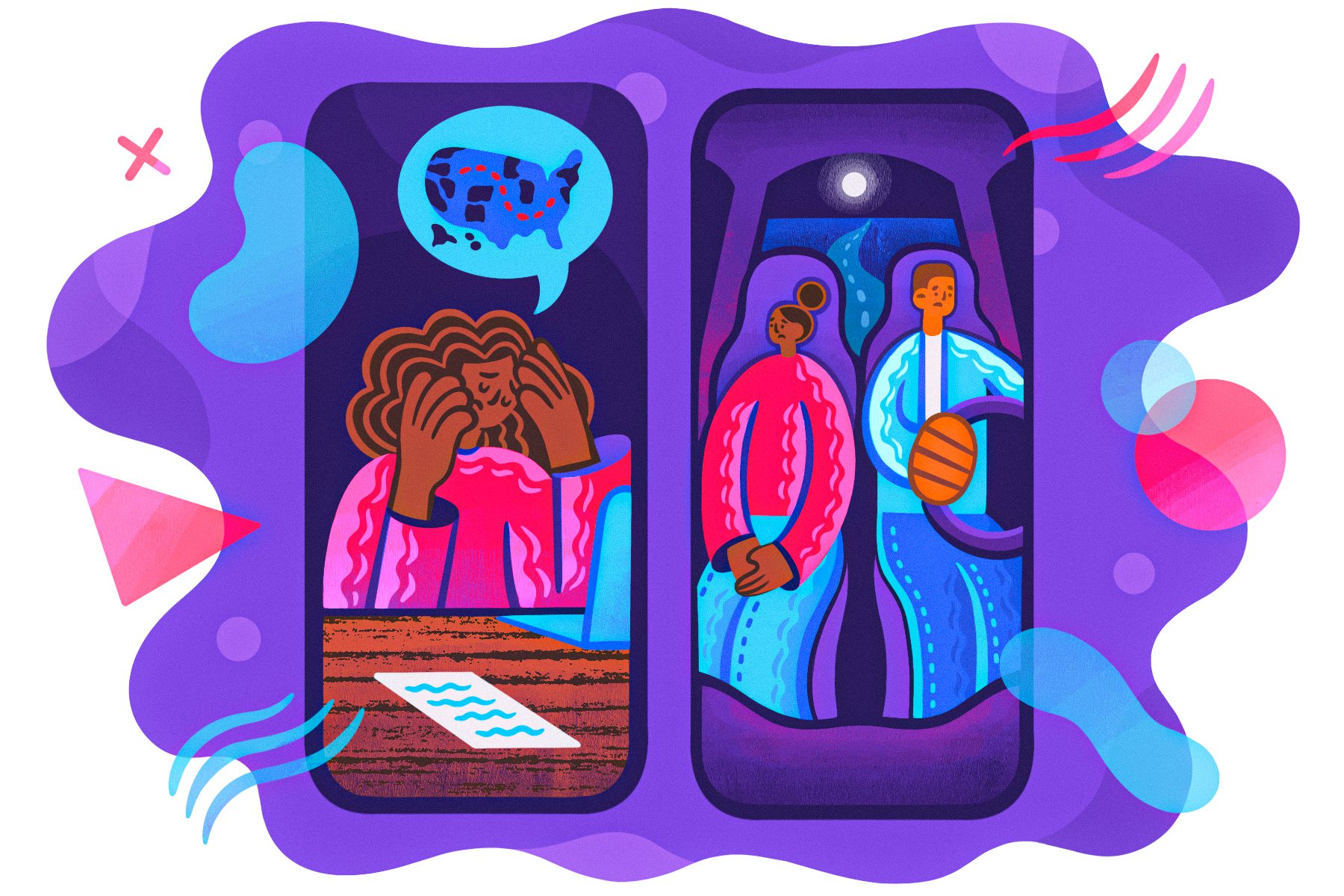Tiff found out she was pregnant on New Year’s Day.
Her period was three days late, just enough to suspect that something was off. Still, when she saw the two pink lines, she was shocked.
She was 16. She didn’t know what to do or what would happen with her parents, whom she describes as conservative.
“I was like, ‘Oh my God. This is it. I’m not going to have a place to live. They’re going to kick me out,’” she recalled.
Tiff, whose full name has been withheld to protect her privacy, wanted an abortion. She went to a gynecologist, who told her she was five weeks and five days pregnant. Since September 1, 2021, Texas law has banned abortion past six weeks of pregnancy.
Her parents didn’t approve of abortion as an option. And because she is a minor, state law required that they would have to sign off on any abortion, unless she could get a state judge to deem her mature enough to decide for herself — a process that could take weeks.
With all of those factors at play, it was all but impossible to get an abortion in Texas. Tiff, who lives just outside of Houston, could theoretically have tried to go out of state — but getting the funds to do that would’ve required convincing her parents. She also considered trying to find abortion pills online. But if none of those options worked, she would give birth shortly after her 17th birthday — still a child herself, living at home.
“I promised myself when I was younger that I would absolutely never raise a kid in my house with my parents,” she said. “I just don’t feel like I can give the baby what he needs to have a good life.”
September 1 will mark one year since Texas became the first state to ban most abortions. The state’s law, known as Senate Bill 8, was without precedent. Rather than criminal punishment, it relied on civil litigation — anyone who “aided or abetted” an illegal abortion could be sued for $10,000. That novel structure allowed it to stay in effect even with Roe v. Wade in place.
Six weeks is an incredibly short window: Because of how pregnancies are dated — people learn they have conceived at the first missed menstrual period, at which point they are already technically four weeks pregnant — the law gave people two weeks at the most to get a legal abortion in the state of Texas.
SB 8 offered a first glimpse into a world without Roe, which for nearly five decades protected the federal right to an abortion. It also provided an early clue that the current Supreme Court, which upheld the Texas abortion ban, might be prepared to overturn the 1973 case. So this summer, when five of the court’s justices struck down Roe — giving states the power to directly and completely outlaw abortion — health care providers, policy researchers and legal experts across the country already had a sense for just how seismic the impact would be. In Texas, they had already seen a trial run.
In the past year, the law’s impact has been expansive. Clinics in nearby states — Oklahoma, Kansas, New Mexico, Colorado and Louisiana — reported a surge in new patients traveling from Texas. Wait times for an abortion ballooned, jumping from a few days to as long as four weeks. The law even inspired copycat legislation in other states, including a law in Oklahoma that took Texas’ punitive structure and applied it to virtually all abortions. That ban took effect in May, banning abortion in yet another state two months before Roe would be overturned.
In 2020, the last full year before SB 8 took effect, Texas recorded about 55,000 abortions performed in the state — the third most in the country, behind only Florida and New York. In 2021, the state recorded closer to 50,000, and the number of abortions performed in September, October, November and December — after the law took effect — fell by about half compared to the previous months in the year. Data from the first three months of 2022, the latest available, shows the number of abortions never picked up; each month, about half as many abortions were performed in state compared to the same timespan a year prior. As of March, about 1,400 people in Texas were traveling out of state for an abortion each month. The number of people requesting medication abortion pills from Aid Access, a European medical service, tripled, research suggests.
The landscape for Texans with unintended pregnancies has completely changed. While some successfully got an abortion in a clinic — either in their home state, or after traveling hundreds of miles to another — countless other did not. Some tried to induce abortions at home with medication abortion. Still others carried their unwanted pregnancies to term.
The 19th spoke with three Texas women who sought an abortion in this past year. Each has a different story. But all shared similar sentiments: anger, sorrow, frustration and fear.
“I would wish this on absolutely no one,” Tiff said.
After learning she was pregnant, Tiff tried for months to find an abortion. But she worried that leaving the state for a procedure could open her up to prosecution when she came home. (It would not.) Her parents’ disapproval made it even harder to consider leaving the state for an abortion.
Tiff looked online for any website that might help her find medication abortion pills. She posted on Reddit, asking for advice. One of her friends gave her mugwort, an herb commonly used by people trying to induce abortions but that evidence suggests is ineffective. She may have tried other herbs, too, she said, but those months are such a blur that it’s hard to remember.
At five months pregnant, Tiff was hospitalized due to concerns about her mental health brought on, she said, by the stress of her pregnancy. It was only then that the reality set in. She was pregnant. There was no way she was getting an abortion. And in a few months, she would have a child.
On August 11, Tiff, 17, gave birth to a son. Her parents are supportive. Her ex-boyfriend is not. Even now, with a weeks-old baby boy, it’s hard for Tiff to fathom what she has been through.
She loves her baby. “But I still ideally would have had that abortion,” she said.
Minors like Tiff have faced a particularly onerous burden. In Texas, people younger than 18 were required to obtain parental consent before they could get an abortion. If their parents were unwilling to provide that, the minor could appeal to a judge in a process known as “judicial bypass” to argue that they were mature enough to get the procedure.
That process could take days or even weeks depending on where in the state someone lived and how quickly the court moved, said Irma Garcia, the client services manager for Jane’s Due Process, a Texas advocacy group that helps minors who are seeking abortions. Those delays could mean missing the six-week window. Unless their parents offered consent, people younger than 18 were typically unable to get approved for an abortion under the Texas law, Garcia said.
And for most, traveling out of state — neighboring New Mexico, for instance, does not require parental notification or consent for minors to get an abortion — wasn’t viable, either. Teens were less likely to have the money, resources and privacy to take multi-day trips without their parents or caretakers knowing.
“Many minors cannot safely get out of the house and maintain confidentiality,” Garcia said. “This was a full abortion ban for many youth in Texas.”
Things are only more difficult now. Since June 24, when Roe was overturned, Texas has begun enforcing a law banning virtually all abortions. Clinics have closed their doors, with some making plans to relocate to neighboring states. Texas’ abortion funds — nonprofit organizations that help people pay for abortions — have stopped covering those costs. And many of the states people in Texas once turned to — Oklahoma, Arkansas, Louisiana and Mississippi — have banned abortions in most circumstances.
“The last year was certainly incredibly difficult for abortion providers, for people needing abortions, for the people who were supporting them,” said Kari White, an associate professor at the University of Texas at Austin and the lead investigator of the Texas Policy Evaluation Project, which has studied the impact of Texas’ six-week abortion ban. “The circumstances are just far poorer now with no in-state abortion being available, and many out-of-state options being shut off, and financial assistance really being curtailed.”

Those neighboring states were critical, said Kaleigh, a Dallas resident. (Kaleigh has told few people about the abortion and requested her full name be withheld.) The 29-year-old took a pregnancy test this past April after she missed her period twice and battled daily nausea. She’d been putting it off, she said — she and her boyfriend weren’t ready to be parents. She was scared of what she would see.
Kaleigh knew about the six-week abortion ban. So she opened her computer and searched the internet for “pregnancy clinics.” One kept appearing at the top of her search list. So she made an appointment, and that Tuesday showed up for her sonogram at the Prestonwood Pregnancy Center, a crisis pregnancy center in the Dallas suburb of Richardson. (The center did not respond to multiple requests for comment.)
“All they did was just asked me about why I was trying to … get an abortion. ‘Do you want to see your baby?’” she recalled.
After the sonogram was complete, they showed her pictures, she said, and gave her a critical piece of information: Kaleigh was eight weeks pregnant. She could not get an abortion in Texas.
Kaleigh and her boyfriend were on the same page. They could drive to another state for an abortion — they had a car, and they had the money. They could work remotely if needed. So she started calling clinics. She tried some in Texas, just in case somehow, they might make an exception. When none could see her, she called the three abortion providers then operating in Louisiana. The earliest appointment she could get wouldn’t be for three weeks.
She couldn’t bear the idea of being pregnant that long.
Finally, Kaleigh found something: a clinic in Sunland Park, New Mexico, just a mile from the Texas border city El Paso. The drive was nine hours, and they could see her that Friday. So on Thursday night, she and her boyfriend drove west. The next morning, she got two pills at the clinic: mifepristone to take there and misoprostol to take at home.
The abortion was a relief, but Kaleigh couldn’t stop thinking about what it took to get it. Ten years ago, at age 19, she’d had an abortion. Then, like in April, she’d found out at eight weeks pregnant.
In 2012, though, she could legally get an abortion in Texas. Per state law, she still had to make multiple visits to the clinic. The process took about a week in total, but she didn’t have to worry about driving for hours across state lines, potentially navigating morning sickness while in transit.
“It was just so much more difficult to figure out how to safely do this, you know?” she said. “It wasn’t a problem 10 years ago. Since the six-week ban, it’s like a totally different place.”
“I feel like the world hates women,” she added. “How can we not take it that way?”
SB 8 is technically still on the books. But it’s now no longer the dominant abortion ban in the state.
Since Roe was overturned, the Texas government began enforcing an abortion ban that predates Roe, one originally passed in the 1800s. It prohibits all abortions, with a narrow exception if the abortion is needed to save the pregnant person’s life. This past Thursday, the state’s trigger ban also took effect. That law replaces a near-total abortion ban with one that also makes abortion a felony, punishable with lifetime imprisonment and a fine of up to $100,000.
“I think it is probably more confusing now than it was a year ago,” said White, the UT professor. “There are essentially no services here. With the exception of New Mexico facilities, and depending on what part of Texas you live in, facility-based abortion services are not nearby.”
Instead, she said, people seeking abortions may try to induce them on their own, through what is called self-managed abortions. Some may use ineffective mechanisms, like certain herbs or vitamin C supplements. Others may do so through dangerous means, such as inflicting physical trauma on themselves.

Abortion providers and reproductive rights advocates are instead trying to help people access mifepristone and misoprostol, the medication abortion pills that people can safely take from their homes. It’s a process that requires knowing someone who can help people safely access authentic, accurately labeled pills.
Maria, also from Dallas, learned she was pregnant in January. Between her vomiting and abdominal pain, she thought she had a terrible stomach bug until she showed up at the hospital and was given a pregnancy test. (Maria is her middle name; she requested her full name be withheld because her family does not approve of the procedure.)
Maria, 27, was five weeks along when she found out. The hospital staff congratulated her, but she didn’t want to be pregnant.
Theoretically, she could have made it to an abortion clinic. But her immigration status is tenuous. Would going to a clinic in Texas show up on her record? Could it jeopardize her ability to live in the United States? Her immigration concerns meant she couldn’t travel out of state, either. She viewed self-managing as her only option.
She texted a woman she knew, someone who worked in reproductive health advocacy. That person had helped Maria six years ago, when she had her first abortion. They connected her with someone else who was based in Texas and could mail her abortion pills. By the time the pills reached Maria’s house, she was six weeks pregnant.
When the first pills came, they were broken. Maria couldn’t use them. When a second set of pills arrived she was seven weeks pregnant. She had heard stories about medication abortions — there could be hours of pain, and a good amount of blood. People had told her that if she needed to go to the hospital, she should just tell them she had miscarried; theoretically, no one would know the difference. But Maria was still afraid. What if someone in the hospital suspected she had an abortion? What if she was arrested anyway?
“I was just really freaked out. I was really scared,” she said.
She took the pills alone in her apartment; the person who had gotten her pregnant didn’t support her getting an abortion, and she didn’t feel able to tell her friends or family. The pain from her abortion lasted two whole days — at some points, Maria said, “I thought I wanted to die.” Even once the pain abated, her bleeding continued about a month longer. She felt awful, but she couldn’t tell anyone.
“People were like, ‘You look really pale.’ I knew why I was pale,” she said. “I was like, ‘Oh, I’m weak, ‘I haven’t had water or eaten well.’”
Maria’s body has recovered. But still, she rarely tells people she knows about the abortion. When she has talked about it, it’s because she wants other people with experiences like hers to know that they’re not alone.
As she has watched abortion rights erode in Texas, that kind of awareness feels even more critical, she said.
“I’m not the only one,” she said. “There’s a lot of girls wanting to have an abortion. And they’re just scared.”







